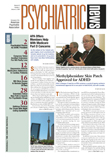Some 6.5 million Americans ceased receiving coverage for their prescription drugs under the Medicaid program on December 31, 2005, and began receiving them the next day under the long-awaited, hotly debated Medicare prescription drug program.
Those 6.5 million “dual eligibles” who qualify for both Medicare and Medicaid—an estimated 2.5 million of whom have mental illness—are the first and possibly most difficult test of the new government program. How well they fare may determine whether the new program will fulfill the promises made by the Bush administration or succumb to the worst fears of critics who have predicted a fiscal and logistical catastrophe.
APA is closely monitoring the rollout of the new benefit and has established an e-mail address—
[email protected]—for psychiatrists and others to write in with complaints, questions, or comments about their experience. Psychiatrists can also call (866) 882-6227.
At press time, Irvin (Sam) Muszynski, J.D, director of APA's Division of Healthcare Systems and Financing, said that while the federal Centers for Medicare and Medicaid (CMS) appeared to be making its best effort to ensure that beneficiaries are properly enrolled and that plan formularies meet their needs, it was less certain how prescription drug plans (PDPs) would carry out those policies.
One move made by CMS just weeks prior to the initiation of the new program was the establishment of a point-of-sale “fail-safe” policy by which dual eligibles who showed up at a pharmacy with identification showing their participation in Medicare and Medicaid would leave with their prescriptions even if they were not enrolled in a PDP.
CMS Administrator Mark McClellan, M.D., M.P.H., made the announcement during a telephone conference in mid-December. It followed filing of a lawsuit by eight advocacy organizations against the government claiming that not enough was being done to ensure enrollment of dual eligibles (Psychiatric News, December 16, 2005).
“CMS is making its best effort to identify and auto-enroll all dual-eligible beneficiaries prior to the effective date of their Part D eligibility,” McClellan said. “However, it is possible that some beneficiaries may go to pharmacies before they have been auto-enrolled in a Part D plan. For this reason, CMS has developed a process for a point-of-sale solution to ensure dual-eligible individuals experience no coverage gap when Part D coverage commences.
“If a beneficiary presents at a pharmacy with evidence of both Medicaid and Medicare eligibility, but without current enrollment in a Part D plan, the beneficiary will be able to leave the pharmacy with their prescriptions, and a CMS contractor will immediately follow up to validate eligibility and facilitate enrollment into a Part D plan,” McClellan said.
“CMS and its contractor will provide a uniform and straightforward set of instructions that all pharmacists can follow no matter which plan network they are in or where they are in the country,” he said.“ To achieve this objective, CMS is contracting with a single national plan to manage a single national account for payment of prescription drug claims for the very limited number of dual-eligible beneficiaries who have not yet been auto-enrolled into a Part D plan at the time they present a prescription at the pharmacy.”
The contractor for CMS is Wellpoint, of Indianapolis, Ind.
Muszynski said the mechanism was a positive development, but he remained cautious about how the Part D program would play out for the neediest and most disabled.
While it seems clear that most of the relevant antidepressants and antipsychotics are included on plan formularies, it remains uncertain whether they would be available in all necessary formulations and dosages. Also uncertain is the degree to which they might be subject to prior authorization or step therapy.
And PDPs have not been forthcoming about details of their plans. For instance, Virginia has reported that one PDP filed suit to prevent the state from issuing “scorecards” so that beneficiaries could compare plans.
Also very unclear even just days before the new program was to begin was the status of medications for substance abuse.
“The availability of substance abuse medication is highly variable across plans, spotty, and inadequate,” Muszynski said. “There remains a fair amount of uncertainty because much of the information is unavailable. With the point-of-sale protection, CMS appears to be trying to do all the right things. The question is whether their policies will hit the mark. APA is prepared to monitor this situation diligently, and we welcome psychiatrists reporting to us about the issues as they occur.”
(Benzodiazepines are explicitly excluded from coverage in the formularies by the Medicare Modernization Act.)
In an interview with Psychiatric News, one pharmacy manager for a PDP that has been endorsed by AARP said that all dosage strengths and formulations of psychiatric drugs would be available to its enrollees.
Mike Anderson, Pharm.D, director of clinical programs and education for Ovations (the business segment within United Health Group that manages services for Medicare beneficiaries) said PDPs typically send one National Drug Code (NDC) to the government for every drug they intend to cover.
“We send the government one proxy code for every drug, but when we do that it is CMS's expectation that we will provide every formulation and strength of the drug that is available,” he said. “Risperdal, for example, is available in a number of forms: tablet, syrup and injectable. We submitted our most highly utilized NDC for Risperdal, which was a one milligram tablet. But by doing that I have obligated us to cover all strengths, dosages, and formulations.” ▪

